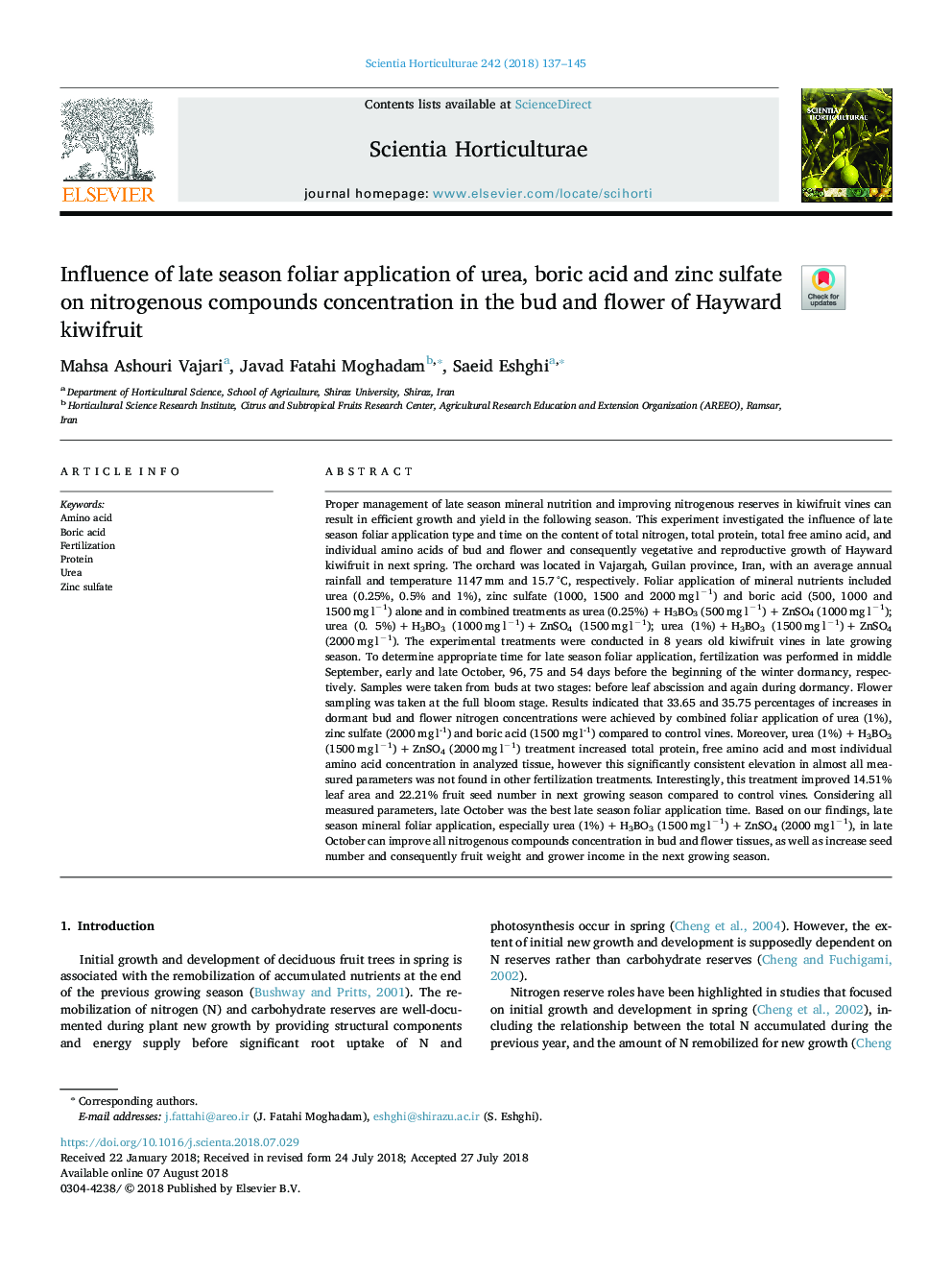| Article ID | Journal | Published Year | Pages | File Type |
|---|---|---|---|---|
| 8892308 | Scientia Horticulturae | 2018 | 9 Pages |
Abstract
Proper management of late season mineral nutrition and improving nitrogenous reserves in kiwifruit vines can result in efficient growth and yield in the following season. This experiment investigated the influence of late season foliar application type and time on the content of total nitrogen, total protein, total free amino acid, and individual amino acids of bud and flower and consequently vegetative and reproductive growth of Hayward kiwifruit in next spring. The orchard was located in Vajargah, Guilan province, Iran, with an average annual rainfall and temperature 1147âmm and 15.7â°C, respectively. Foliar application of mineral nutrients included urea (0.25%, 0.5% and 1%), zinc sulfate (1000, 1500 and 2000âmgâlâ1) and boric acid (500, 1000 and 1500âmgâlâ1) alone and in combined treatments as urea (0.25%)â+âH3BO3 (500âmgâlâ1)â+âZnSO4 (1000âmgâlâ1); urea (0. 5%)â+âH3BO3 (1000âmgâlâ1)â+âZnSO4 (1500âmgâlâ1); urea (1%)â+âH3BO3 (1500âmgâlâ1)â+âZnSO4 (2000âmgâlâ1). The experimental treatments were conducted in 8 years old kiwifruit vines in late growing season. To determine appropriate time for late season foliar application, fertilization was performed in middle September, early and late October, 96, 75 and 54 days before the beginning of the winter dormancy, respectively. Samples were taken from buds at two stages: before leaf abscission and again during dormancy. Flower sampling was taken at the full bloom stage. Results indicated that 33.65 and 35.75 percentages of increases in dormant bud and flower nitrogen concentrations were achieved by combined foliar application of urea (1%), zinc sulfate (2000âmgâl-1) and boric acid (1500âmgâl-1) compared to control vines. Moreover, urea (1%)â+âH3BO3 (1500âmgâlâ1)â+âZnSO4 (2000âmgâlâ1) treatment increased total protein, free amino acid and most individual amino acid concentration in analyzed tissue, however this significantly consistent elevation in almost all measured parameters was not found in other fertilization treatments. Interestingly, this treatment improved 14.51% leaf area and 22.21% fruit seed number in next growing season compared to control vines. Considering all measured parameters, late October was the best late season foliar application time. Based on our findings, late season mineral foliar application, especially urea (1%)â+âH3BO3 (1500âmgâlâ1)â+âZnSO4 (2000âmgâlâ1), in late October can improve all nitrogenous compounds concentration in bud and flower tissues, as well as increase seed number and consequently fruit weight and grower income in the next growing season.
Related Topics
Life Sciences
Agricultural and Biological Sciences
Horticulture
Authors
Mahsa Ashouri Vajari, Javad Fatahi Moghadam, Saeid Eshghi,
